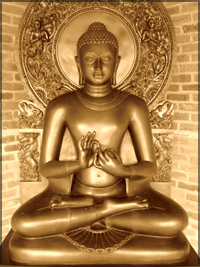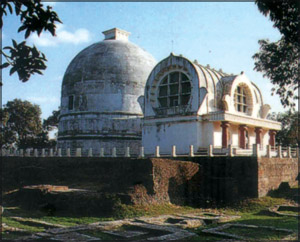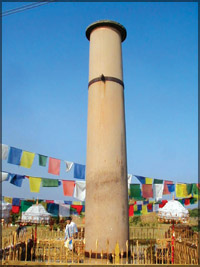The place where the Buddha was born
Lumbini
is the place where the Buddha, known as the Tathagata* was born. It is
the place which should be visited and seen by a person of devotion and
which should cause awareness and apprehension of the nature of
impermanence.' * Tathagata - One who has found the Truth.
Being one of the four holy places of Buddhism. It is said in the
Parinibbana Sutta that Buddha himself identified four places of future
pilgrimage: the sites of his birth, enlightenment, first discourse, and
death. All of these events happened outside in nature under trees. While
there is not any particular significance in this, other than it perhaps
explains why Buddhists have always respected the environment and natural
law.
Lumbini is situated at the foothills of the Himalayas in modern
Nepal. In the Buddha's time, Lumbini was a beautiful garden full of
green and shady Sal trees (Shorea). The garden and its tranquil environs
were owned by both the Shakyas and Kolias clans.
King Suddhodana, father of Gautama Buddha was of the Shakya dynasty
belonging to the Kshatriya or the warrior caste. Maya Devi, his mother,
gave birth to the child on her way to her parent's home in Devadaha
while taking rest in Lumbini under a sal tree in the month of May in the
year 642 B.C.
The beauty of Lumbini is described in Pali and Sanskrit literature.
Maya Devi it is said was spellbound to see the natural grandeur of
Lumbini. While she was standing, she felt labor pains and catching hold
of a drooping branch of a Sal tree, the baby, the future Buddha, was
born.
In 249 BC, when the Emperor Ashoka visited Lumbini it was a
flourishing village. Ashoka constructed four stupas and a stone pillar
with a figure of a horse on top.
Lumbini remained neglected for centuries. In 1895, Feuhrer, a famous
German archaeologist, discovered the great pillar while wandering about
the foothills of the Churia range. Further exploration and excavation of
the surrounding area revealed the existence of a brick temple and a
sandstone sculpture within the temple itself which depicts the scenes of
the Buddha's birth.
It is pointed out by scholars that the temple of Maya Devi was
constructed over the foundations of more than one earlier temple or
stupa, and that this temple was probably built on an Ashokan stupa
itself.
On the south of the Maya Devi temple there is the famous sacred
bathing pool known as Puskarni. It is believed that Maha Devi took a
bath in this pool before the delivery. In 1996, an archaeological dig
unearthed a "flawless stone" placed there by the Indian Emperor Ashoka
in 249 BC to mark the precise location of the Buddha's birth more than
2,600 years ago, if authenticated, the find will put Lumbini even more
prominently on the map for millions of religious pilgrims.
Recently, several beautiful shrines have been built by devotees from
Buddhist countries. A visit to Lumbini, the birthplace of Buddha, is not
only for spiritual enlightenment but also for solace and satisfaction
that one gets in such a calm and peaceful place.
"Bodh Gaya is the place where Gautama Buddha attained unsurpassed,
supreme Enlightenment. It is a place which should be visited or seen by
a person of devotion and which would cause awareness and apprehension of
the nature of impermanence".
Siddhartha Gautama, the Buddha-to-be, had been dwelling on the banks
of the Nairanjana River with five ascetic followers for six years
practicing austerities. Realising that austerities could not lead to
realisation he abandoned them. His five ascetic companions disgusted at
his seeming failure, deserted him and left for Sarnath.
The Maha Bodhi Temple
 The
historical place at which the Enlightenment took place became a place of
pilgrimage. Though it is not mentioned in the scriptures, the Buddha
must have visited Bodh Gaya again in the course of his teaching career.
About 250 years after the Enlightenment, the Buddhist Emperor, Ashoka
visited the site and is considered the founder of the Mahabodhi Temple. The
historical place at which the Enlightenment took place became a place of
pilgrimage. Though it is not mentioned in the scriptures, the Buddha
must have visited Bodh Gaya again in the course of his teaching career.
About 250 years after the Enlightenment, the Buddhist Emperor, Ashoka
visited the site and is considered the founder of the Mahabodhi Temple.
The temple's architecture is superb but its history is shrouded in
obscurity. It was constructed with the main intention of making it a
monument and not a receptacle for the relics of the Buddha. Several
shrines were constructed with enshrined images for use as places of
worship.
The basement of the present temple is 15m square, 15m in length as
well as in breadth and its height is 52m which rises in the form of a
slender pyramid tapering off from a square platform. On its four corners
four towers gracefully rise to some height.
Inside the temple there is a colossal image of the Buddha in the
"touching the ground pose", bhumisparsha mudra. This image is said to be
1700 years old and is facing east exactly at the place where the Buddha
in meditation with his back to the Bodhi tree was enlightened.
The Bodhi Tree
For seven days after the Enlightenment, the Buddha continued to
meditate under the Bodhi tree without moving from his seat. During the
second week he practiced walking meditation.
A jewel walk, Chankramanar, was built as a low platform adorned with
nineteen lotuses which are parallel to the Maha Bodhi temple on its
north side. For another week the Buddha contemplated the Bodhi tree. In
this place a stupa was built called Animeschalochana situated to the
north of the Chankramanar.
Many sacred trees in India and other countries are originally raised
from seeds brought from the ancient Bodh Gaya tree. A shoot of the
original Bodhi tree was taken to Sri Lanka in the 3rd century B.C. by
Bhikkhuni Sangamitta, daughter of Ashoka, where the Lankan king
Devanampiyatissa planted it at the Mahavihara monastery in Anuradhapura
where it still flourishes today.
Around the Bodhi tree and the Mahbodhi temple there are quadrangular
stone railings around 0.2m high with four bars including the top piece.
These are of two types and can be distinguished from each other in style
and material used. The older set is dated to about 150 BC and made of
sandstone while the latter set is probably of the Gupta period (300-600
AD) and constructed from course granite.
Since 1953, Bodh Gaya has been developed as an international place of
pilgrimage. Buddhists from Sri Lanka, Thailand, Burma, Tibet, Bhutan and
Japan have established monasteries and temples within easy walking
distance of the Mahabodhi compound. The site of the enlightenment now
attracts Buddhists and tourists from all over the world.
Sarnath-The First Teaching
After attaining enlightenment at Bodh Gaya the Buddha went to Sarnath;
and it was here that he preached his first discourse in the deer park to
set in motion the 'Wheel of the Dharma'.
A Monastic tradition flourished for over 1,500 years on the site of
the deer park at Sarnath. In the third century BC Ashoka erected a
column 15.24 m in height which had four lions as its capital which is
now treasured in the archaeology museum. The lion symbolises both
Ashoka's imperial rule and the kingship of the Buddha.
The four-lion capital was adopted as the emblem of the modern Indian
republic. The last and largest monastery constructed before the Muslim
invasion was Dharma-Chakar-Jina Vihar, erected by Kumardevi, wife of
King Govinda Chandra, who ruled over Benares during 1114 to 1154. In
1194 AD, Kutubuddin Aibak, the Muslim conqueror, leveled the city to the
ground.
Sarnath became a forest of debris below which the historical ruins
remained buried. Of the two great stupas which adorned the city only the
Dhamekha remained which is of the 6th century.
The Dhamekha Stupa
 This
is the most conspicuous structure at Sarnath. Colonel Cunningham bore a
shaft from the top centre of the stupa and discovered a stone tablet on
which an inscription is written with the word Dhamekha, and mentions
that this is the spot where the Buddha delivered his first sermon. The
design consists of a broad band of Swastika (fylfot) carved in different
geometrical patterns with a finely chiselled lotus wreath, running over
and below the swastikas. This
is the most conspicuous structure at Sarnath. Colonel Cunningham bore a
shaft from the top centre of the stupa and discovered a stone tablet on
which an inscription is written with the word Dhamekha, and mentions
that this is the spot where the Buddha delivered his first sermon. The
design consists of a broad band of Swastika (fylfot) carved in different
geometrical patterns with a finely chiselled lotus wreath, running over
and below the swastikas.
The Dhamekha stupa is considered to be the sacred place where the
voice of Buddhism was first heard. Many dignitaries of Buddhist
countries visit this place for circumambulation of this sacred stupa and
to worship the Buddha. Tibetans Buddhist circumambulate it chanting the
mantra 'Om mani padme hum'.
The first discourse of the Buddha was on the 'Wheel of Law'. The
wheel symbolises samsara (world), the eternal round of existence which
goes on and on, life after life because of ceaseless cravings and
desire.
The Ramabhar Stupa: The Buddha's cremation place, Kusinara.
Mahaparinirvana (the great passing away). It was the full moon of the
month of Vaisakha (April-May) and the year was probably between 487 and
483 B.C. However, according to the Sri Lankan tradition and other
southeastern countries, it is believed that the Buddha entered
Parinirvana in 544-543 B.C.
For the next six days the body of the Great Master was laid in state.
Preparations were made for his funeral
 under
the direction of Anirudha a cousin and follower of the Buddha. On the
seventh day, after honouring the body with perfumes and garlands, it was
taken to the Mukutbandhana Chaitya, the sacred shrine of the Mallas. under
the direction of Anirudha a cousin and follower of the Buddha. On the
seventh day, after honouring the body with perfumes and garlands, it was
taken to the Mukutbandhana Chaitya, the sacred shrine of the Mallas.
The last ceremony was performed by Maha Kasapa and the body of the
Great Master was cremated with due honour. When the cremation was
completed the ashes were collected by the Mallas as relics, which
consisted of a skull bone, teeth and inner and outer shrouds.
The relics were then distributed into eight shares amongst the
representatives of the other eight Kingdoms which constituted ancient
northern India. These relics were again subdivided after King Ashoka
decided to build 84,000 stupas. Today these relics are enshrined in
stupas across Asia.
Mahaparinirvana Temple, Kusinara.
The present temple was built by the Indian Government in 1956 as part
of the commemoration of the 2,500th year of the Mahaparinivana or 2500
BE (Buddhist Era).
Inside this temple, one can see the famous Reclinging Buddha image
lying on its right side with the head to the north. The statue is 6.1 m
long and rests on a stone couch. On the front of the couch are three
sculptures, believed to represent Ven. Ananda near the feet, Ven.
Subhadda at the middle and Ven. Dabba Malla at the corner.
At the centre is an inscriptionof the 5th century AD, which states
the statue was "a gift of the monk Haribala of the Mahavihara and was
fashioned by Dinna". This 1500-year old reclining Buddha image was
executed out of one block of red sandstone brough in from Mathura during
the Gupta period.
It was discovered in 1876 in a dilapidated condition and the
scattered fragments were successfully pieced together. Excavation showed
that the original temple on the site consisted of an oblong hall and
antechamber with its entrance facing the west. Large number of bricks
with carved surfaces found among the rubbish indicated that the temple
had a barrel-vaulted roof not unlike that on the modern temple. |
